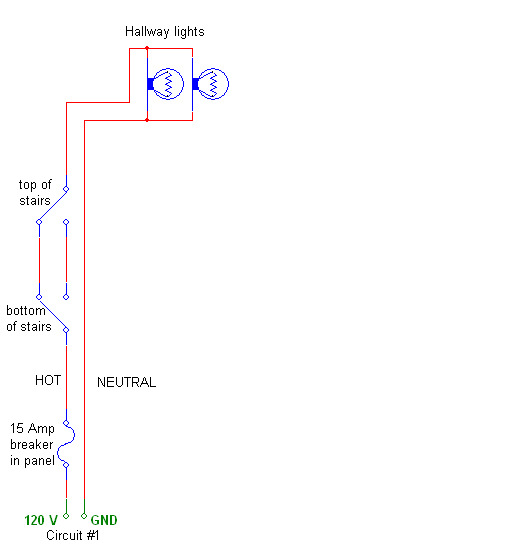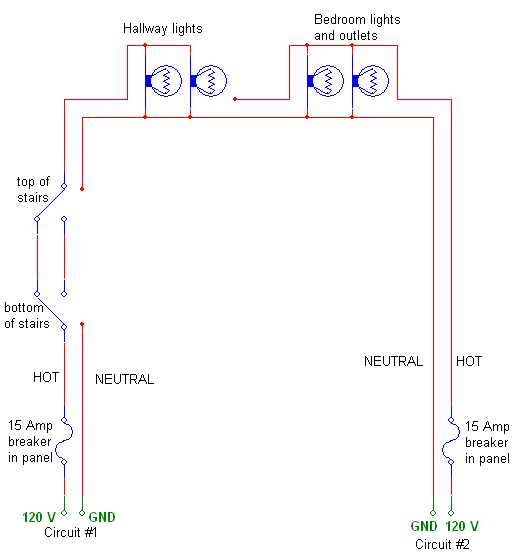I was installing a ceiling fan in a bedroom in my house last weekend when I found that my home was badly miswired by the original builders. The current wiring works, but is unsafe and clearly in violation of the national electric code. (The home was built in 1995, when the builders REALLY should have known better.) This turned out to be a nice circuits example for my intro physics class, so I thought I’d also post it here as an example of stuff you can learn in school that’s actually practical in real life.
The issue is the wiring of some hallway lights which are controlled by two switches at the top and bottom of the staircase. The picture below shows how it’s supposed to be wired, using two “three-way switches.” (Confusingly, they’re apparently called “two-way switches” in the UK.) Note that three separate wires (as in 3-wire cable) are required between the two switches.

What happened in my house is this: the electrical contractors apparently ran out of 3-wire cable, and instead ran only 2-wire cable between the two switches. This left them with no neutral wire to complete the circuit from the hallway lights. Instead, they ran a cable to the bedroom, and connected to a neutral from a completely different branch circuit. The wiring they did is shown below:

Here’s a quick quiz: what’s wrong with what they did?
Actually, there are three things wrong with it:
- In general, you want the supply and return current paths of a circuit to be near each other. Big open loops in a circuit path tend to cause interference, degrading circuit performance. (In some cases, they can also lead to inductive heating of metal structures near the wires, though not here.) But this is the least of the problems.
- A much more serious problem is that the neutral wire in circuit #2 (for the bedroom) gets more current than it’s designed for. The wires in circuit #2 are designed to handle only 15 Amps; any more, and the circuit breaker is supposed to shut the circuit off. But in the diagram above, if the other lights and outlets in the bedroom draw 14 Amps through the breaker, and the hallway lights draw 2 Amps, then the neutral (return) wire for Circuit #2 carries 16 Amps, which is above its limit. That’s a fire hazard.
- Another serious problem with this scheme is that a person working on circuit #2 (say, me, installing a ceiling fan) would typically turn off the breaker for circuit #2 and assume that he is safe. But in fact, the neutral wire in this circuit still carries current from the hallway lights. Breaking the neutral wire and touching it could lead to a nasty shock. That’s how I found out something was wrong with my house: my hand brushed against a neutral wire and I got zapped. I was uninjured, but this is serious: people have died because of this.
Now the really technical part:
I’m not a licensed electrician, but I believe this work is in violation of the National Electric Code, also known as NFPA 70. In the situation above, the possibility of overcurrent in the neutral wire (grounded conductor) of circuit #2 appears to violate article 210.20.
Interestingly, I actually have two different places in my house that suffer from this defect. One is exactly as I described above; the second is a little more subtle, because the two circuits are actually on different phases. If the two hot wires (ungrounded conductors) are 180 degrees out of phase, the current in the shared neutral wire is actually the difference between the two currents, avoiding the overcurrent situation. Bizarrely, I believe this makes the out-of-phase wiring scheme technically legal under older (pre 2005) versions of the code, when my house was built. I think the two circuits would fall under the category of “multiwire branch circuits,” defined in article 100 and governed by article 210.4 (also known as “edison circuits” or “shared neutral circuits” or “common neutral circuits”). Fortunately, this section of the code has been modified, and the newest version (2008) includes provisions in articles 210.4(B) and 210.7(B) that the two branch circuits must be equipped with a means to disconnect them simultaneously, such as a double pole breaker with a common trip tie in the panel box. This prevents someone from disconnecting only one of the two circuits and mistakenly believing the circuit is safe to touch. In my opinion, this update to the code is long overdue.
A quick note of clarification: although the preferred method of wiring a three way switch is to run a neutral wire from the same feed as the hot wire (using three-wire cable between the switches), there’s nothing sacred about that arrangement. As long as the neutral wire coming from the lights is eventually connected back to the same branch circuit that the hot wire came from, there is no safety issue, though wrongness aspect #1 above still applies. Three-wire cable is more expensive than two-wire cable, and two-wire cable can be safely used between three way switches, provided that the wire with white insulation is permanently reidentified by color as an ungrounded conductor, consistent with article 200.7(C)(1) and 200.7(C)(2). (Were the white wires in my house between the two switches reidentified? Of course not.)


